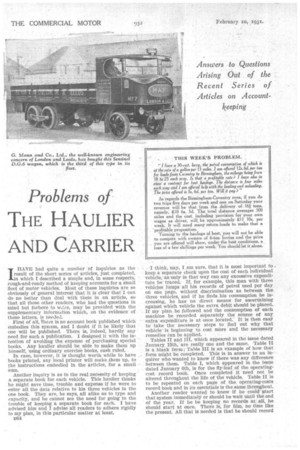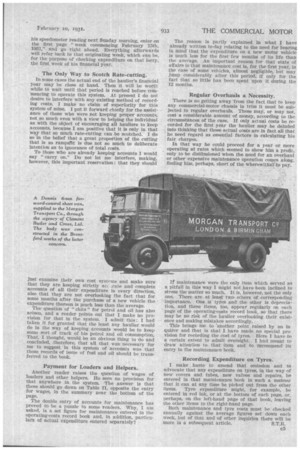Problems of
Page 134

Page 135

If you've noticed an error in this article please click here to report it so we can fix it.
THE HAULIER
AND CARRIER
IHAVE had quite a number of inquiries as the . result of the short series of articles, just completed, in which I described a simple and, in some respects, • rough-and-ready method of keeping accounts for a small fleet of motor vehicles. Most of these inquiries are so obviously of general interest that it is clear that-I can do no better than deal with them in an article, so that all those other readers, who had the questions in mind but forbore tow...',:e, may be provided with the supplementary information which, on the evidence of these letters, is neede-.1.
First of all, there is no account book published which embodies this system, and I doubt if it be likely that one will be published. There is, indeed, hardly any need for such a publication. I designed it with the intention of avoiding the expense of purchasing special• books. Any haulier should be able to make them up himself, using ordinary exercise books, cash ruled.
In case, however, it is thought worth while to have , books printed, any local printer will make them up, to the instructions embodied in the articles, for a. small sum.
Another inquiry is as to the real necessity of keeping a separate book for each vehicle. This haulier thinks he might save time, trouble and expense if he were to enter all the data relative to his three vehicles in the one hook. They are, he says, all alike as to type and capacity, and he cannot see the need for going to the trouble of keeping a separate book for each. I have advised him and I advise all readers to adhere rigidly to my plan, in this particular matter at least.
D64
-• I think, nay, I am sure, that it is most important to. keep a separate check upon the cost of each individual vehicle,-as -only in that way can any excessive expenditure be traced. If, for example, this man with three vehicles lumps all his records of petrol used per day on one page, without discrimination as between the three vehicles, and if he finds his consumption be increasing, he has no direct means for ascertaining against which vehicle the extra debit should be placed. If my plan-be followed and the consumption of each machine be recorded separately the source of any extra expenditureis at once located. It is then east to' take the necessary steps to find out why that vehicle is beginning to cost more and the necessary remedies Can be applied.
Tables II and HI, which appeared in the Issue dated January, 13th, are really one and the same. Table II is a blank form; Table III is an example of how that form might be completed. This is in answer to an inquirer who wanted to know if there was any differenee between them. Table 1, which appeared in the issue dated January 6th, is for the fly-leaf of the operatingcost record book. Once completed it need not be altered throughout the life of the vehicle. Table II is to be repeated on each page of the operating-costs record book and in its essentials is the same throughout.
Another reader wanted to know if he could start that system immediately or should he wait until the end of the year. If he be keeping no records at all, he should start at once. There is, for him, no time like the present. All that is needed is that he should record his speedometer reading next Sunday morning, enter on the first page "week commencing February 15th, 1931," and go right ahead. Everything afterwards will refer back to that originating week, which can be, for the purpose of checking expenditure on that lorry, the first week of his financial year.
The Only Way to Scotch Rate-cutting.
In some cases the actual end of the haulier's financial year may be close at hand. Then it will be worth while to wait until that period is reached before commencing to operate this system. At present I do not desire to interfere with any existing method of recording costs. I make no claim of superiority for this system of mine. I put it forward chiefly for the assistance of those who were not keeping proper accounts, not so much even with a view to helping the individual as with the object of encouraging all hauliers to keep accounts, because I am positive that it is only in that way that so much rate-cutting can be scotched. I do so in the belief that a great proportion of the cutting that is so rampallt is due not so much to deliberate intention as to ignorance of total costs.
To those who are already keeping accounts I would say "carry on." Do not let me interfere, making, however, this important reservation: that they should just examine their own cost systrms and make sure . that they are keeping strictly ac ■ irate and complete accounts of all their expenditure in every direction, also that they are not overlooking the fact that for some months after the purchase of a new vehicle the expenditure thereon is much less than the average. The question of " chits " for petrol and oil has also arisen, and a reader points out that I make no provision for that in the system. I admit this : I had taken it for granted that the least any haulier would do in the way of keeping accounts would be to keep some sort of track of his petrol and oil consumption. That, I thought, would be an obvious thing to do and concluded, .therefore, that all that was necessary for me to suggest in this system of accounts was that those records of issue of fuel and oil should be transferred to the book.
Payment for Loaders and Helpers.
Another reader raises the question of wages of loaders and other helpers. He sees no provision for that anywhere in the system. The answer is that these should go down on Table II, opposite the entry for wages, in the summary near the bottom of the page.
The double entry of accounts for maintenance has proved to be a puzzle to some readers. Why, I am asked, is a set figure for maintenance entered in the operating-casts record book and, in addition, particular8 of actual expenditure entered separately?
The reason is partly explained in what I have already written to-day relating to the need for bearing in Mind that the expendittire on a new motor vehicle is much less for the first few months of its life than the average. An important reason for that slate of aEairs is that maintenance cost is, for the first year, in the case of some vehicles, almost negligible, but may jump considerably after this period, if only for the fact that so little has been spent upon it during the 12 months.
Regular Overhauls a Necessity.
There is no getting away from the fact that to keep any commercial-motor chassis in trim it must be subjected to regular overhauls. These may, or may not, cost a considerable amount of money, according to the circumstances of the case. If only actual costs be recorded for the first year the haulier may be deluded into thinking that those actual costs are in fact all that he need regard as essential factors in calculating his fair charges.
In that way he could proceed for a year or more operating at rates which seemed to show him a profit, only to be disillusioned when the need for an overhaul or other expensive maintenance operation comes along, finding him, perhaps, short of the wherewithal to pay.
If maintenance were the only item which served as a pitfall in this way I might not have been inclined to stress the matter so much. It is, however, not the only one. There are at least two others of corresponding importance. One, is tyres and the other is depreciation, and these items, too, appear regularly on each page of the operating-costs record book, so that there may be no risk of the haulier overlooking their existence and making mistakes accordingly.
This brings me to 'another point raised by an inquirer and that is that I have made no special provision for recording the cost of tyres. Here I have to a certain extent to admit oversight. I had meant to draw attention to that item and to recommend its entry in the maintenance book.
Recording Expenditure on Tyres.
I make haste to amend that omission and to advocate that any expenditure on tyres, in the way of new covers and tubes, new valves and repairs, be entered in that maintenance book in such a manner that it can at any time be picked out from the other items. Tyre expenditure might, for example, be entered in red ink, or at the bottom of each page, or, perhaps, on the left-hand page of that book, leaving the other items to the right-hand page.
Both maintenance and tyre costs must be checked annually against the average figures set down each week, but of that and of other inquiries there will be more in a subsequent article. S.T.R.




























































































































































































